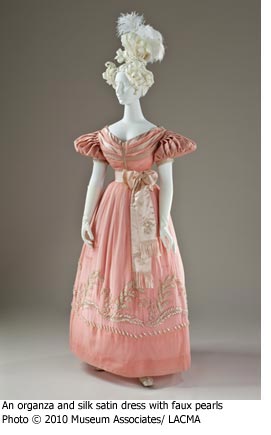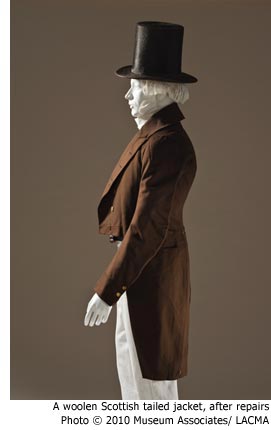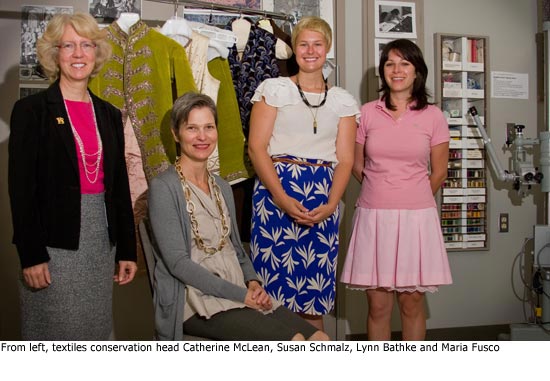Stitches in time for grand old gowns
July 29, 2010
There’s nothing like the prospect of a glamorous Los Angeles debut to make even the most luxurious wardrobe cry out for a little freshening up.
 Especially when the clothes are hundreds of years old.
Especially when the clothes are hundreds of years old.
When Catherine McLean, the head of textile conservation at LACMA, got the assignment to prepare about 250 ornate European dresses, gowns, suits and accessories for exhibition, the pressure was on.
Not only would it be a race against the clock to ready the garments for the upcoming “Fashioning Fashion: European Dress in Detail, 1700-1915.” McLean and her team also would have hands-on responsibility for spiffing up one of the museum’s hottest acquisitions in recent years—the multimillion dollar Kamer-Ruf collection, made up of more than 1,000 garments and accessories and named for the two European art dealers who assembled it.
Just landing the collection was a major coup.
“This really is a transformative acquisition,” says LACMA costume and textiles department curator Kaye Spilker, who curated the show with Sharon Takeda, the department head and senior curator. “I would think it puts us into the first tier of museum collections as regards the quality of the objects.”
The deadline wasn’t negotiable, either. The exhibition, which will explore the changing styles and techniques of fashions of the gentry and aristocracy, had to be ready for the October 2 grand opening of the new Renzo Piano-designed Resnick Pavilion.
That meant just two years for McLean and company to accomplish hundreds of tasks: refurbishing, stitching, cleaning and otherwise preparing for their close-ups hundreds of outfits that once were among the most glamorous in the Western world.
Work on the new collection was both inspiring and, occasionally, a source of “sheer terror” for McLean.
“We were pretty worried we wouldn’t be able to get it all done in time,” says McLean. “[But] the fact that this collection was so amazing was a real motivator. The pieces just light up the whole room.”
Facing the large job was McLean’s small crew. She and associate textiles curator Susan Schmalz are the only permanent staffers. They work with Maria Fusco, funded by a year-long Mellon Fellowship, and summer intern Lynn Bathke. Their base is a studio in LACMA’s Conservation Center, near specialists in paintings, three-dimensional objects, paper and scientific research.
A 30-year LACMA veteran, McLean found her vocation early. She got a volunteer job at a Detroit museum in high school where she enjoyed even the lowly task of removing linings from tapestries. “I was hooked,” she recalls, and after grad school came west to LACMA. She’s worked on modern clothing, pre-Columbian cloth and the museum’s famous Ardabil Carpet, once owned by J. Paul Getty.
 Textile conservation straddles a line between science and art. The conservators must know the chemistry of dyes and cleaning solvents as well as art history and the properties of dozens of fabrics. Deftness and patience are required for all the sewing, weaving and knitting involved.
Textile conservation straddles a line between science and art. The conservators must know the chemistry of dyes and cleaning solvents as well as art history and the properties of dozens of fabrics. Deftness and patience are required for all the sewing, weaving and knitting involved.
“The conservators do very exacting work under a lot of pressure,” says Spilker. “They are very good, and in their work they can’t make a mistake.”
The collection was in excellent condition. But time can damage a 200-year-old dress, no matter how well cared for.
First, they had to kill any potential pests by placing the items in freezers or oxygen-free nitrogen containers. Then they conducted a careful inventory, writing a detailed conditions report for every item in the show. They made the most complicated repairs first, saving the easiest for last.
Some highlights of their labors:
- A pink silk gown, from England, dating to 1830, had rips and tears thanks to its weighty decorations—architectural shoulders stuffed with horse hair and hundreds of faux pearls. Fusco re-stitched old repairs and mended new spots. She replaced the horse hair to repair the shoulders and added new glass pearls, though without using the original method of obtaining iridescent dye from fish scales. “We’re not trying to fool anybody” by exactly matching the originals, says Fusco.
- Silk stockings were a sexy item in 1700, but they tended to run back then, too. Schmalz is still working on repairing runs in a pair of silk knit women’s hose, embroidered with silvery birds and plants. (Curators found a similar stocking depicted in a scene in one of William Hogarth’s “A Rake’s Progress” paintings.) She’s making the repairs using tiny “insect pins,” a crocheting needle and a magnifying lens. “This is my most challenging piece,” says Schmalz, who once, on a free-lance assignment, helped restore an Elvis Presley jumpsuit.
- The team applied new techniques to old problems. A man’s tailed jacket from Scotland, dating from 1845, was pocked with a half dozen moth holes. Normal repairs leave a slight indentation, so Fusco borrowed a technique from home crafters called “needle felting.” Dying loose woolen fleece to the precise shade of brown, she took a square of spare cloth and jabbed the needle quickly up and down until there was a soft brown circle the size of the hole. The result: a near perfect match in color, texture and depth.
- “Fashioning Fashion’s” final piece, a black and gold silk ball gown purportedly worn by Queen Maria II of Portugal in about 1850, started life with a regal 12-foot train. But the train was trimmed in the 1890s, leaving the team struggling to understand how it was originally attached to the dress. So they sewed a piece of new cloth to restore the full length, and then experimented with several methods of pleating to attach the train to the bodice until they got the ideal fit. “Sometimes you have to improvise until it looks right,” says McLean.
After months of tense work juggling color coded charts of “to-do” items, the team is nearly done. By mid-August, mannequins with the clothing will begin to move into the Resnick Pavilion.
McLean is looking forward to viewing the show as a spectator, and says “there’s something magic about an exhibition.”
Even when you know the location of every secret stitch and fix.
Posted 7/29/10




















 405 bridge work causes a stink
405 bridge work causes a stink